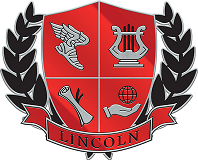Interdisciplinary Projects and Exhibitions
Interdisciplinary Projects and Exhibitions
Engaging 21st Century Learning
At Lincoln our learners will engage with authentic problems that develop critical thinking and prompt the development and application of their knowledge and skills in all disciplines – language arts, mathematics, science, social studies, the arts – with meaningful career and technology connections and innovations.
Staff and teachers are developing integrated learning experiences grounded in standards with tangible artifacts that meet multiple standards and can provide evidence of learning in multiple classes.
Learning begins with curiosity, engagement and wonder. We will cultivate 21st century competencies by framing learning experiences where students explore their lives and the world under the umbrella of a theme, concept, phenomenon, or event. Our learners engage with authentic problems that develop critical thinking and prompt the development and application of their knowledge and skills in all disciplines – language arts, mathematics, science, social studies, the arts – with meaningful career and technology connections and innovations.
Two ways we will be developing 21st century competencies:
First: The development of two semester-long foundational design classes to prepare grade 9 and 10 students (and staff) to use the Innovation-Lab (I-Lab).
The Innovators Lab (I-Lab) will be an open resource to all students and an important part of students integrated learning experience. A variety of workspaces and tools including 3D printers, laser cutters, CNC milling machines, a vinyl cutter, 2D and 3D design software, an electronics bench, microcontrollers, power tools, and traditional hand tools provide the resources for the exploration and implementation of creative ideas while also enhancing collaborative opportunities among teachers in the fields of design, engineering, arts, and science. It will be a place to examine world problems and develop/create ideas and solutions that supports project-based learner experiences.
- Design Fundamentals – In this hybrid class, students spend the first semester exploring the fundamentals of art and design through a variety of digital machines, mixed media, material exploration, and computer design software. In the second semester students spend time in the visual arts classroom learning how to use fine arts tools and techniques to develop their drawing, painting, sculpting, and printmaking skills.
- Prototyping and Design – Students are introduced to the digital fabrication equipment and then utilize those tools to generate their own independent project. Each student designs and prototypes a project that aligns with a particular area of interest – product design, furniture design, electrical engineering, robotics, coding or programming.
- Next Generation Science Engineering Standards – Students will design, evaluate, and/or refine a solution to a complex real-world problem, based on scientific knowledge, student-generated sources of evidence, prioritized criteria, and tradeoff considerations.
Second: Twice yearly exhibitions of interdisciplinary learning:
Public exhibitions of student learning promote:
- High Quality Work for Authentic Audiences: When students know they will share their work with an audience beyond the classroom, they are motivated to make it high quality. The best exhibitions showcase work that has required students to think critically, problem solve, and revise through multiple drafts. Exhibitions will be a great way to share student writing, art work, performances, debates, experiments, engineering projects, mock trials, podcasts, videos or artifacts that show evidence of student learning of specific academic learning outcomes and 21st century competencies.
- Community and Family Involvement: Exhibitions put students center stage as they describe the process and products of their learning. Like a sports event or performance, they bring families and community members together to celebrate the collective work of a class, a team or a school. But with exhibitions, the community is taking pride in students’ academic learning.
- Equity: Exhibitions set the expectation that all students, not just a select group, are capable of producing high-quality work and will share that work with people beyond their classroom. They motivate all students to do their best, so they can stand proudly beside their work.
